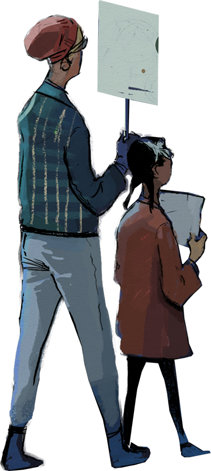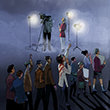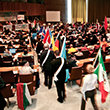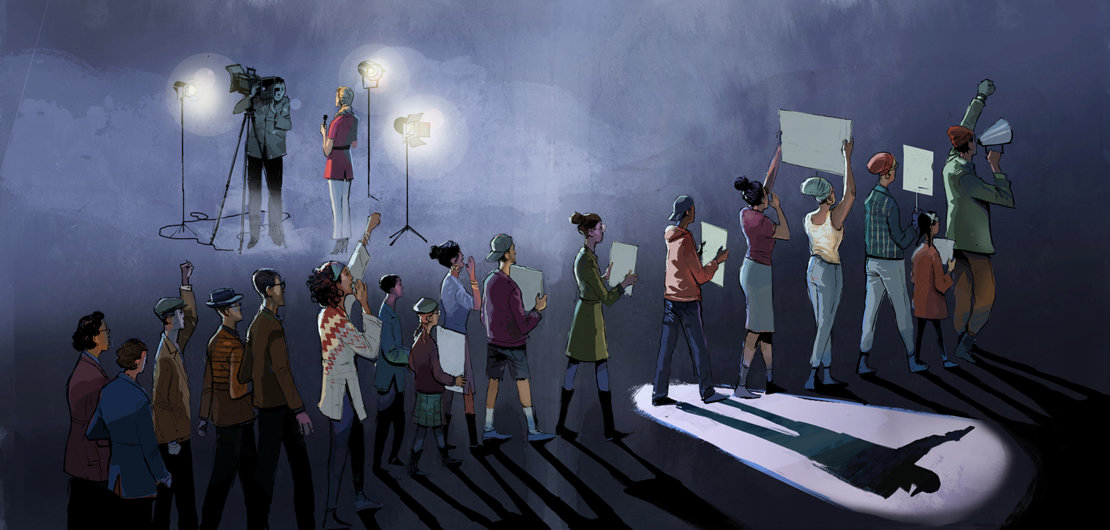In 1968, the college town of Gainesville, Florida, like most of the nation, was roiling with racial unrest, and more fuel was being splashed on the discontent by an unpopular war in Vietnam. Gainesville was the South, after all, and the local newspaper, The Sun, teamed up with the white law enforcement establishment to silence any inquiry into racism, poverty and, as the black community saw things, the white police occupation of African-American neighborhoods. State Judge J.C. Adkins shut down Black Voices, the only newspaper in the town with an African-American perspective, declaring in the fine Southern tradition of wiping his feet on the U.S. Constitution that the journal was a “clear and present danger.” Federal judges would later slap down that affront to the First Amendment.
But before the federal jurists ruled, other events swept the nation into a maelstrom. The Kerner Commission, created by President Lyndon Johnson, tried to examine the causes of race riots that had ravaged large swaths of American cities the year before. On April 4, barely a month after the commission’s weak-tea report was released, the Rev. Martin Luther King Jr. was assassinated in Memphis.
Scores of American cities erupted. The anger raged higher when still another assassination occurred: Robert F. Kennedy on June 6.
In Gainesville, two young black girls had been molested while in police custody, and an all-white grand jury whitewashed the cops. Skirmishes began on the streets. Judge Adkins craftily marginalized anyone who supported civil rights as “white beatniks” and “Black Power.”
The judge then made a not-subtle clarion call: “If I ever get my hands on [the demonstrators], I hope they get to the court without a lynching.” Hint, hint.
I wrote about those events as a young journalist for what was then called an “underground” newspaper. Even then I realized the power of words and the media.
Judge Adkins couldn’t officially endorse lynching, but he brought up the idea and implicitly made it a reasonable reaction for white citizens. The local daily newspaper amplified the fear and hatred among the white, middle-class citizenry.
Almost four decades later, in 2006, I wrote about the centennial of the Atlanta Race Riot. Oh? You haven’t heard about that terrible conflagration in 1906? You’re not alone. Almost no one in Atlanta had been told the story. One reason was a dearth of information from the daily newspaper, The Atlanta Journal-Constitution, which, along with the business elite in the city has steadfastly tried to bury their own roles in many racist events.
A century earlier, there were three newspapers, including the then separately owned Constitution and Journal. Top bosses at the two newspapers were vying to become governor, and they each competitively fanned racial hatred as the preferred Southern way to political success. Running newspapers gave them the ultimate soapbox for demagoguery. One Journal headline screamed: “BLACK FIEND.” The Constitution retaliated with lurid claims of black men stalking white neighborhoods and raping girls—with never a bit of facts in the accusations.
My youthful articles in 1968 targeted one major flaw with the Kerner Commission: It wasn’t exactly race at fault for the riots; it was institutionalized poverty. A member of the Commission, former U.S. Sen. Fred Harris of Oklahoma, had the same worry in 1998: “[T]hirty years after the Kerner Report, there is more poverty in America, it is deeper, blacker and browner than before, and it is more concentrated in the cities, which have become America’s poorhouses.”
Cut to Baltimore, Maryland, circa now.
When Freddie Gray died April 19 from spinal injuries while in custody of Baltimore police, the ensuing events in the city had exactly the same root causes as riots in Detroit and Newark in 1967, with one techno twist: today’s ubiquitous presence of cell phone recordings, which spreads anger and response much faster than a half century ago.
Freedom Senior Writer Ray Richmond has covered the traumatic civic convulsions in Ferguson, Missouri, and in this issue of the magazine he scrutinizes Baltimore. Among many strong analyses in his report, Richmond notes that the media was largely absent when a man was killed while in police custody and when demonstrations were non-violent. Only when a tiny fraction of demonstrators started looting and burning did the media swarm in.
Here’s what most media did not report: Nationally, white family net worth is 13 times that of blacks; in constant dollars, white household net worth increased 11 percent since 1984, while black household net worth plunged 10 percent. In Baltimore, 23 percent of the citizens live below the poverty line, and almost all of them are people of color. There is a 20-year difference in life expectancy between the wealthy white areas of Baltimore and the black ghettos. White and black Baltimore citizens smoke marijuana at the same rates, yet 92 percent of the arrests are for African-Americans. Since 2011, $5.7 million has been paid out in about 100 police brutality claims in Baltimore.
With these statistics readily available, a perceptive, nuanced look would be in order. It seldom comes. As political columnist and writer Gore Vidal once observed, we live in the “United States of Amnesia.” The mainstream media—and politicians—used racial dog-whistle signals to identify “thugs” burning property during “riots.” CNN’s Wolf Blitzer adamantly would not let people assert that a broken spine was more awful than broken windows. U.S. Sen. Rand Paul of Kentucky blamed events in Baltimore on “lack of fathers.” Poverty? Generational hopelessness? Property rights over human justice? Forget it.
Most of America—white America—believes that urban riots are a black thing. By any standard, that’s tragically hilarious.
Part of the cultural amnesia is that most of America—white America—believes that urban riots are a black thing. By any standard, that’s tragically hilarious. Historian Gregory Downs has written that “more than 50,000 African-Americans were murdered between emancipation and 1887.” Most of those were killed by white mob violence. There were scores of white-on-black race riots in the early part of the 20th century, plus more than 4,000 lynchings that continued well into the 1960s. You can’t condone violence, but the events since the 1960s, including Baltimore, have real reasons and many of those reasons are the voting disenfranchisement, predatory economics aimed at minorities, and physical attacks on blacks that were seldom addressed or even acknowledged in earlier generations.
There’s another word to explain the riots: Injustice. Economic poverty in itself doesn’t often erupt in riots. The lack of justice—spiritual poverty—is a more accurate predictor of riots and revolution. L. Ron Hubbard, Scientology’s founder, makes that point in a column on the last pages of this magazine. We are courting national self-immolation if we tolerate a society in which many people are deprived of justice, whether economic, social, marital or with police and courts.

To that list of human behaviors demanding justice, one more is essential: Religion. Although a cornerstone of the United States is religious liberty, we are at a time when denigration of faith is a popular pastime, especially with some members of the press. Yes, it is quite proper to criticize radical, violent offshoots of a religion. But criticism morphs into bigotry when entire faiths are scapegoated and slimed.
For our society to survive—to prosper in happiness—all citizens must know they are treated justly. Justice must apply in courtrooms and with cops, in schools and workplaces, at places of worship and religious study. Tolerance is the first step in achieving that.
The alternative to justice and tolerance was witnessed in the horrible events in Baltimore. Personal actions—by civilians or the police—can’t be excused. But the language used in depicting the events is precisely the lingo of amnesia. The media don’t remember what happened 50 years ago, or why. The press sees Baltimore as something new and unexplained.
And thus we condemn ourselves and our society to intellectual nothingness. Hatred and injustice prevail.






















